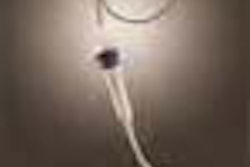Introduced to the radiology community two years ago, tissue harmonic imaging in ultrasound has quickly proven itself useful for abdominal imaging. International researchers sought to quantify THI's benefits in evaluating abdominopelvic lesions and other pathologies in three studies reported at the European Congress of Radiology conference in March.
In a Turkish study, carried out between June and September 1999, 90 abdominal or pelvic lesions were evaluated in 71 patients with both conventional ultrasound and tissue harmonic imaging. Images were obtained with an ATL HDI 5000 scanner and an accompanying C5-2 probe that scans between 2 and 5 MHz. The images were interpreted by three radiologists with at least four years of experience in ultrasonography, said Dr. Cem Yucel from Gazi University in Ankara, Turkey.
Tissue harmonic imaging improved overall image quality of the lesions in the range of 74%-84%, Yucel reported. It also aided in lesion characterization in a minimum of 28 cases. Overall, the three readers agreed that tissue harmonic imaging increased quality in 62% of the cases and helped define lesion characterizations in 17% of the cases.
In addition to reducing artifacts, tissue harmonic imaging allows for easier solid/cystic differentiation, shortens exam time, and is effective for imaging small lesions, Yucel concluded.
In a German study, tissue harmonic imaging was particularly effective for evaluating patients who are difficult to examine because of obesity, hypertrophic muscles, or noise artifacts. Researchers from Wurzburg University studied 150 non-obese and 50 obese patients with both conventional ultrasound and tissue harmonic imaging.
Tissue harmonic imaging was able to increase the differentiation between solid and liquid structures such as complicated cysts, said presenter Dr. Christine Kessler. Pathological findings were easier to verify with THI than conventional ultrasound. In 93% of the non-obese patients, the image quality was better, and in 92% of those who were difficult to examine, pathological findings were clearer, the study concluded.
Finally, a second German study also found that the readers preferred THI to fundamental gray-scale imaging. A total of 44 patients (27 without pathology and 17 with) were imaged with a Siemens Sonoline Elegra scanner and transducers of 3.5 MHz and 7.5 MHz. Half the sonographic images were done with THI and were read by five reviewers. Image quality was scored from 1 to 5, with 5 being the highest score.
Conventional sonography was given an average score of 2.1 compared to the THI images, which were given an average rating of 1.5, said Dr. Sergej Filimonow of the University of Humboldt in Berlin. The readers preferred tissue harmonic images 87% of the time, he added.
However, THI has some limitations. It is unable to provide usable information from the deeper part of tissues, and cannot consistently differentiate between the different kinds of stones found in the gall bladder, Yucel said.
The potential for diminished axial resolution because of a narrower transmit beam width, and a longer pulse length, is another issue, added Dr. Terry Desser of Stanford University in California, commenting after the conference.
The way tissue harmonic imaging is implemented into the probe can affect outcomes. But the advent of transducers that are enabled with harmonic mode at several frequencies can minimize or eliminate some problems, such as a broadband probe manufactured by Acuson of Mountain View, CA, she said.
"These minor effects are essentially negated by the overwhelming improvement in contrast resolution that you get with harmonic imaging," Desser said. "THI just gives you added confidence that what looks like a simple cyst is really just a simple cyst."
By Shalmali Pal
AuntMinnie.com staff writer
April 3, 2000
Let AuntMinnie.com know what you think about this story.
Copyright © 2000 AuntMinnie.com

















